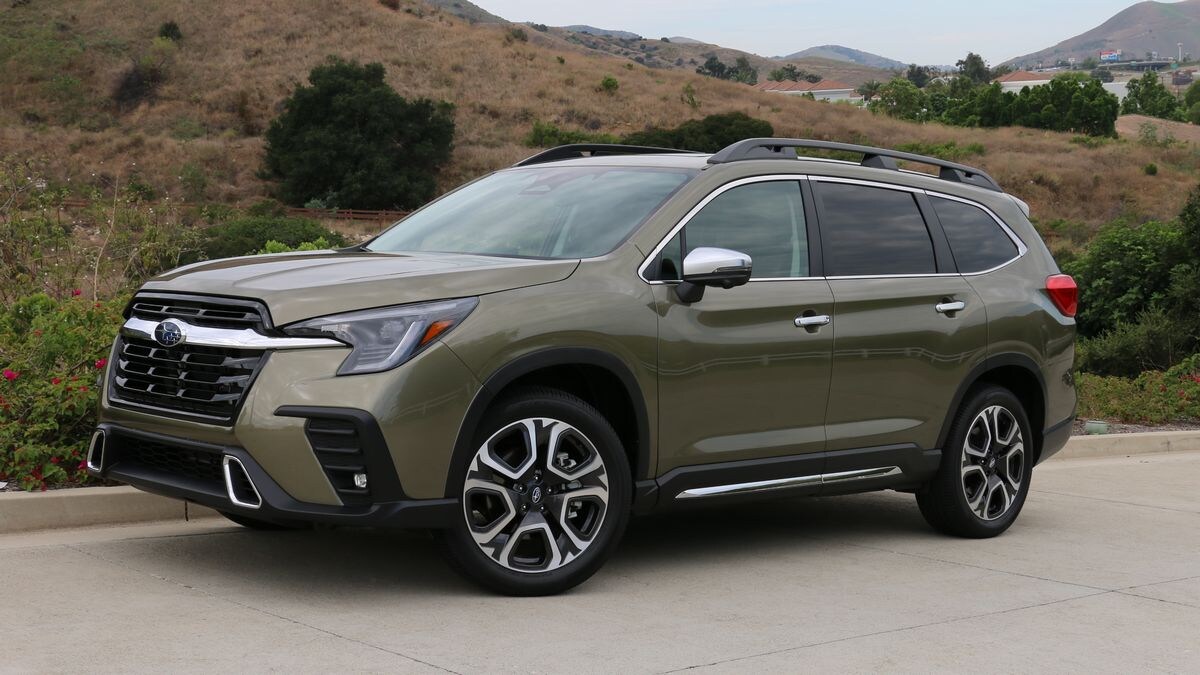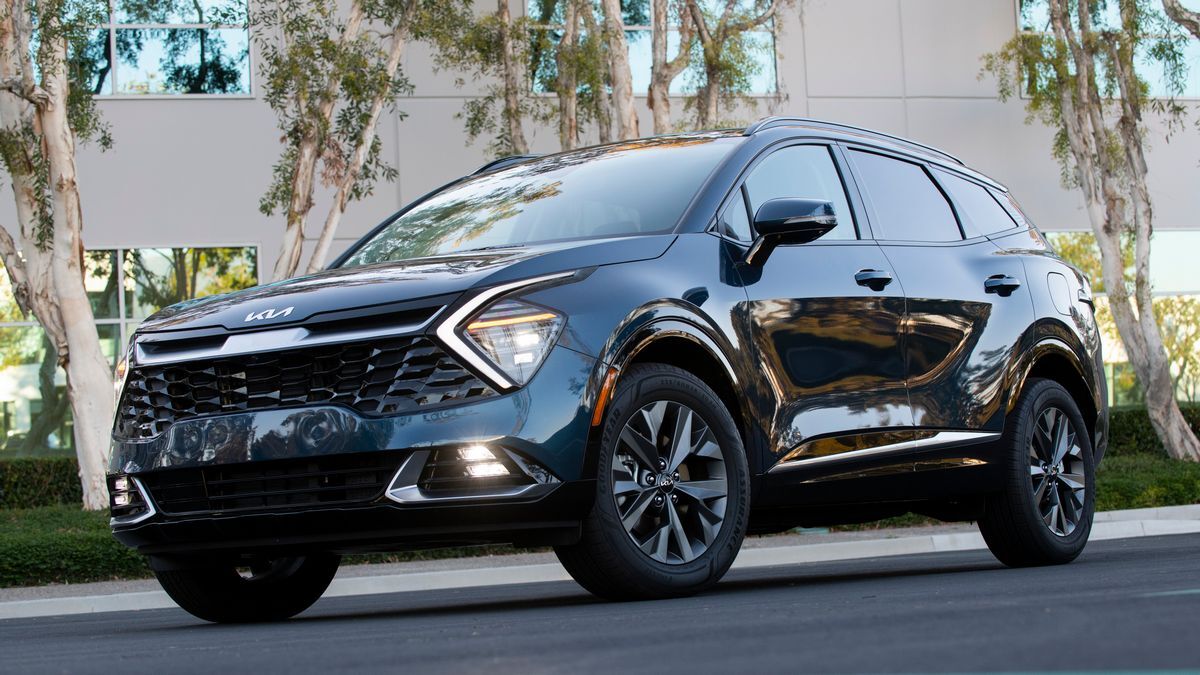The United States is a land of pickup trucks. Trucks take four slots in this year’s top 10 best-selling vehicles list. But wait. Compact SUVs, those plucky utility vehicles, take three slots of the top 10 and seven of the top 20. We gathered the Kelley Blue Book editorial staff in Southern California for three days of driving to evaluate and compare four popular compact SUVs, each with a firm footing in the top 20 for sales this year.
This drive may have been our biggest event ever, with more than 20 drivers sharing time in the vehicles. We started in Irvine, Kelley Blue Book’s California home base, and drove a very long route to Palm Desert. We spent a day in Palm Desert driving loops, collecting notes and impressions, and exploring the SUVs as drivers and passengers. The next day, we drove back to Irvine to compare our observations and driving experiences.
We examined all aspects of the collected SUVs, including:
- Power and refinement
- Highway driving
- Steering and brake feel
- Advanced driver assist systems (ADAS)
- Infotainment
- Cockpit
And then, we debated our findings to determine an overall ranking for the group.
Our biggest realization confirmed a frequent conclusion: Stiff competition has bred a solid group of compact SUVs. While there are differences between the vehicles, all of them are quite good. Most buyers will decide based on taste, budget, and priorities.
Still, we did find a leader in the compact SUV class. Read on to discover our rankings.
1. 2025 Honda CR-V
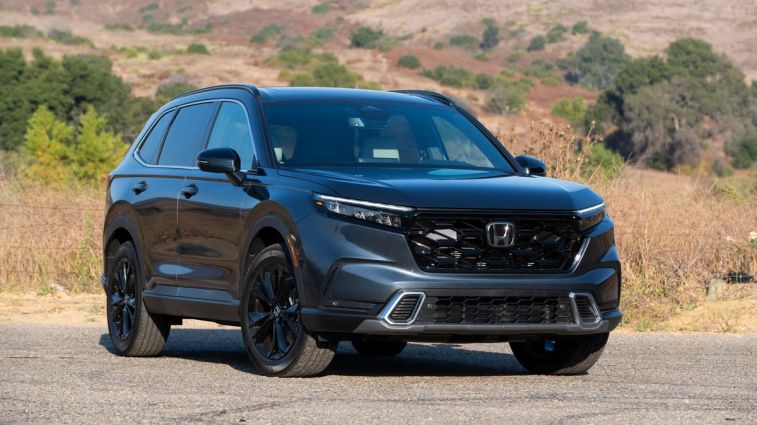
In a sea of compact SUVs, the Honda CR-V remains the easiest model to recommend. Why and how does the CR-V stand out from the rest? It excels at almost everything it does, giving it broad appeal to a wide set of buyers. This Honda also makes life easy, whether it’s shuttling small families, serving faithfully as a daily commuter, or helping keep more money in your pocket.
Over hundreds of miles in our multi-day test drive, everyone who drove the CR-V enjoyed it. And everyone drove the CR-V. The 2025 Honda CR-V might be the one thing in the world that everyone can agree on these days. The overall sentiment from our diverse group of testers is that the CR-V is the best in its class. This determination wasn’t a surprise as much as an affirmation. After all, the Honda CR-V has been the segment winner in its class for our Best Buy Awards seven out of 10 times – so far – giving up the award twice to its archrival, the Toyota RAV4, and once to the always-evolving Kia Sportage.
In our testing, we applauded Honda’s compact SUV for its smooth, refined, and easy driving manners; its comfortable seats and roomy passenger area front and back; and its loads of cargo space, all aided by the lowest load floor among rivals.
We bet Honda has saved many a backache with that facet.
Hybrid Powertrain Makes It Even Better
We recommend one more thing for what is already our most recommendable compact SUV: Get the hybrid version.
In addition to being more potent than CR-V models with the gasoline-only engine (204 horsepower with the hybrid versus 190 for the gasoline-only), the CR-V Hybrid is, of course, more fuel efficient. The hybrid powertrain earns 40 mpg in combined city/highway driving in front-wheel-drive (FWD) form or 37 mpg with all-wheel drive (AWD). That’s a respective 10 and 9 mpg better than the gas-only version.
The addition of electrons only added to the CR-V’s refinement in our testing. “If you want to know what finesse feels like in a compact SUV, drive the CR-V Hybrid,” gushed one of our veteran expert test drivers. “The most comfortable of the bunch,” raved another staffer, adding that it “eats up bumps for lunch.” Other traits we love about the Honda CR-V include its conservative yet handsome styling, its high build quality, and its standard suite of safety and driver assistance systems that includes adaptive cruise control with lane-keeping assist.
Then there are the wonderful small touches you don’t even realize are there until they help you out. For instance, if the fan speed is on full – it was, as we were in 115-degree heat in the desert – and you interact with the infotainment system, the CR-V momentarily turns down the fan speed so you can hear and be heard.
The angels are in the details.
– Senior Editor Matt Degen
2. 2025 Hyundai Tucson
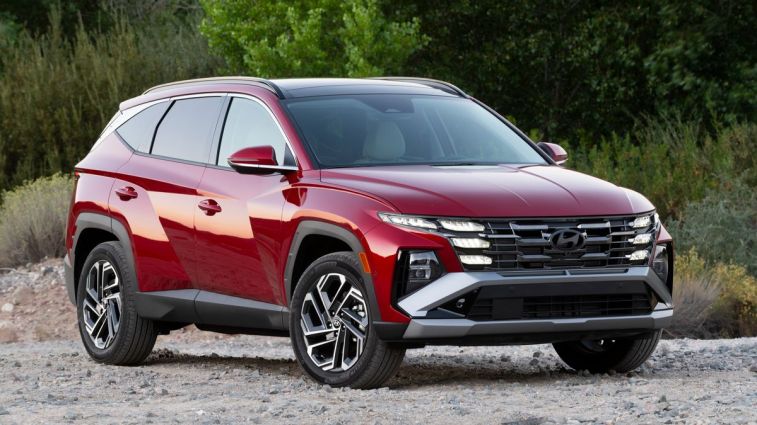
There are so many great details to the 2025 Hyundai Tucson, and the Tucson gets all the basic stuff right, too, like the class-leading warranties, generous cabin space, smooth ride, and overall sophistication. For example, we rated the Tucson a close second to the Honda CR-V in terms of drivetrain refinement. Really close, like the thickness of a dragonfly’s wing.
The cabin has a clean, futuristic interior design. It’s open and airy even with the sunroof closed. The look and feel is akin to one of the more affordable luxury marques like Acura or Infiniti, and the Tucson’s cabin was lauded as our collective favorite by quite some margin.
We like the new steering wheel badge depicting the letter H in Morse code. The gearshift mounted on the steering column didn’t gain universal acclaim among our testing team, but most of us liked it. We appreciate the logic of the operation, moving forward to get into Drive and twisting it back to select Reverse. And keeping it out of the center console (the traditional spot) contributes to the Tucson’s excellent use of space. We all noticed the abundance of storage nooks, adored the dual-level center console, and liked how the wireless charging pad could accommodate phones with bigger camera lenses.
Naturally, our eyes were drawn to the dual-screen unit housing an instrument cluster and the infotainment touchscreen (upgraded for 2025). This kind of thing is prevalent in vehicles from Mercedes-Benz and BMW; now, it’s making it into the mainstream, with Hyundai being one of the early adopters. The infotainment system itself is easy to use, in our experience, and we had no issues connecting our phones (wirelessly). In this top Limited trim, a head-up display is also included — another erstwhile luxury feature. So is the fingerprint sensor that can load personal profiles.
Compact yet Generous
One attractive aspect of the exterior is the lighting. We think the multipoint headlights are cool. And this Tucson has a Baby Mode smoothing out accelerator inputs so as not to disturb any sleeping tots.
As mentioned above, the Tucson is roomy. A 6-footer can sit behind an adult male of average size and still be completely comfortable. We know, because we tried it. That tall person in the back can even enjoy reclining rear seats.
Up front, meanwhile, we noted the particularly comfortable headrests and effective seat ventilation (another perk of the Limited trim, a popular choice among Tucson buyers). During our discussions of cabin materials, we agreed that the Tucson had the best combination.
If ultimate cargo space is a top priority, the Honda CR-V has a couple more cubic feet of cargo area. But we think most people will still be impressed by the Tucson’s luggage-swallowing abilities.
Quiet and Smooth, but Could Use More Oomph
None of us were especially thrilled by the Tucson’s 187 hp. Then again, this is on the same kind of level as a non-hybrid Honda CR-V or Toyota RAV4, and we wouldn’t call it underpowered. It accelerates up to freeway speeds easily enough and enables the driver to go for gaps in the traffic. If we had to do a long trip in the Tucson, we’d relish the prospect. A 2-hour freeway trundle in this quiet and smooth SUV felt like nothing.
Adding to the good driving vibes are the steering and braking systems. We liked their responses and how they required just the right amount of effort to be satisfying and confidence-inspiring. And we don’t think there are better driver assistance features among mainstream manufacturers than those in Hyundai and Kia vehicles. The adaptive cruise control is easy to engage and works just as it should, while the Highway Driving Assist function keeps the Tucson within its lane. This Limited trim also has the Blind-Spot View Monitor, showing live video down the sides of the vehicle in the instrument cluster. It’s much better than regular blind-spot monitoring, and there’s nothing like it in a CR-V or a RAV4.
In our final deliberations, we placed the 2025 Hyundai Tucson second in this group of compact SUVs, putting the Honda CR-V on top. It wasn’t a particularly easy decision. The crucial aspects were the drivetrains, especially the CR-V’s fuel-efficient yet lively hybrid setup (a non-hybrid Tucson with all-wheel drive achieves an unremarkable 25 mpg in a combination of city and highway driving) and Honda’s longstanding reputation for reliability that’s reflected in its stronger resale values. Nevertheless, our opinion of the Tucson is high and we’re more than happy to recommend it.
– Senior Editor Colin Ryan
New 2025 Hyundai Tucson Prices
|
Retail Price
|
Fair Purchase Price (92620)
|
|||
|---|---|---|---|---|
$30,200 |
$28,336 |
|||
$32,060 |
$29,973 |
|||
$34,510 |
$32,313 |
|||
$34,510 |
$32,367 |
|||
$40,140 |
$37,590 |
3. 2024 Toyota RAV4
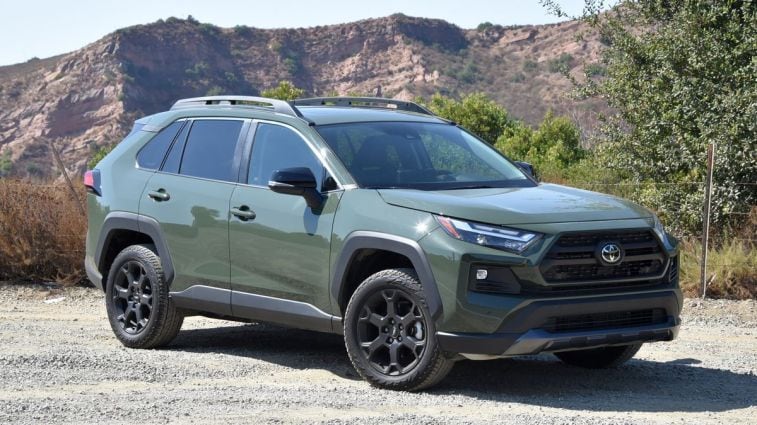
Among the perennial favorites of our editors, the Toyota RAV4 has earned a spot on several of our “Best of…” lists, such as Best Cars and SUVs for Snow, Best Commuter Cars and SUVs, and Best Compact SUVs. In fact, there was no way we were going to conduct a compact SUV comparison drive without the RAV4 represented. Granted, a healthy portion of our RAV4 enthusiasm derives from Toyota’s reputation for durability, reliability, and resale value. However, we think the RAV4 goes beyond the brand’s stature, delivering a better-than-average example of what a compact SUV should be. It didn’t disappoint.
Let me say this and get it out of the way early: The RAV4 is more 4Runner than Highlander. In other words, it’s a bit rough around the edges, certainly more coarse than the Honda CR-V or the Hyundai Tucson. Now, some of that had to do with the TRD Off-Road trim (and its all-terrain tires) on our $41,725 test RAV4. However, even in more refined trims, the RAV4 leans more toward rough-and-ready than cushy and quiet.
Ease of use is a huge consideration for many compact SUV owners. Maximizing a compact SUV’s space and utility is easier in some than in others. We gave the RAV4 high marks for several features, which enabled us to get the most out of it. For example, the 90-degree rear door openings ease the loading and unloading of people and cargo. Moreover, it gives stressed-out parents more maneuvering space when belting a fidgeting little princess into a car seat. Big control knobs facilitate their use with gloved hands. An available power rear hatch makes for easy access when your arms are full of groceries or camping gear.
Power and Fuel Economy
As for power, the RAV4 landed right in the middle of our competitive group. Acceleration from the 203-hp 4-cylinder mill is adequate for most circumstances and requirements. As senior editor Matt Degen put it in his review of the RAV4, “Its naturally aspirated 2.5-liter 4-cylinder engine won’t light streets on fire … but it’s more than enough for keeping up with traffic and easy highway cruising.” Representing the other extreme, tester Rob Nestora quipped, “Lord have mercy, it’s slow.” We all appreciated the traditional 8-speed automatic transmission over the continuously variable automatic transmissions (CVT) in some competitors.
Perhaps the most common gripe about the RAV4 voiced by our testers is the amount of noise this little 4-cylinder engine generates. This raucousness caused the CR-V to lose some ground in the overall scoring.
Among this competitive group, the front-wheel-drive RAV4’s mileage ties with the equivalent CR-V at an estimated 30 mpg in combined city-and-highway driving. At 28 mpg, Toyota’s all-wheel-drive TRD Off-Road slips by one to the Honda’s all-wheel-drive efficiency.
The RAV4 scored roughly in the middle of the pack for many of the categories we noted, including driving dynamics (suspension, steering, and brake feel). The suspension is tighter than others in our competitive group. The ride wasn’t harsh by any means, but many a bump was transferred from the rubber to the seat of our pants. Steering and braking are suitable for a vehicle that, by its very nature, won’t be driven too hard. Senior editor Allyson Harwood felt the RAV4 was the most stable and well-planted of the group.
Initially refamiliarizing ourselves with each competitor by opening and closing doors and rear hatches, climbing around inside each SUV, and noting such things as USB ports and cupholders, we got a feel for how each stacked up against the others. For the RAV4, we appreciated its reclining second-row 60/40-split seat with its center armrest and rear-seat HVAC vents, the interesting texture on the inside of the door pulls, and its two USB-C ports conveniently located for rear-seat passengers. Senior editor Renee Valdes noted the Lexus-like matte finish on the dash, while Matt Degen praised the comfortable seats. Where the RAV4 lags a bit is cargo space. Whether measuring behind the second row or with that seat folded, the RAV4 trails the CR-V, Tucson, and Subaru Forester. However, we appreciated the second-row seat releases located in the cargo area.
Solid Technology
Polling our testers, we determined that most felt the RAV4’s technology was competitive within the group. The infotainment system, in particular, scored well. Resident wordsmith Colin Ryan pithily summed it up as “easy to negotiate.” We had mixed reviews for the smallish infotainment touchscreen, with most testers thinking that it should be bigger. We did have a consensus that the backup camera’s resolution was the worst in this competitive set.
Every RAV4 comes with Toyota Safety Sense 2.5, a fairly comprehensive array of features like lane-keeping assist and automatic emergency braking with pedestrian detection. We appreciate that it also includes full-speed adaptive cruise control. As with many compact rivals, adding blind-spot monitoring and rear cross-traffic alert requires moving up the trim list or checking an options box. Points to the Hyundai Tucson for including these extras in its basic safety tech bundle.
When all was said and done, no one seemed surprised the RAV4 ranked third behind the Honda CR-V and Hyundai Tucson. The RAV4 is an ideal pick for someone who likes the power delivery from a naturally aspirated engine funneled through a traditional automatic gearbox. In other words, no turbo lag, the burst of extra torque from real downshifts, and decent fuel economy. Oh, and there’s that Toyota reputation for reliability, too. In most other areas, the RAV4 stands tall in the middle of the pack.
– Senior Editor Russ Heaps
New 2025 Toyota RAV4 Prices
|
Retail Price
|
Fair Purchase Price (92620)
|
|||
|---|---|---|---|---|
$30,645 |
$28,978 |
|||
$32,155 |
$30,408 |
|||
$35,045 |
$33,258 |
|||
$38,950 |
$37,118 |
4. 2025 Subaru Forester
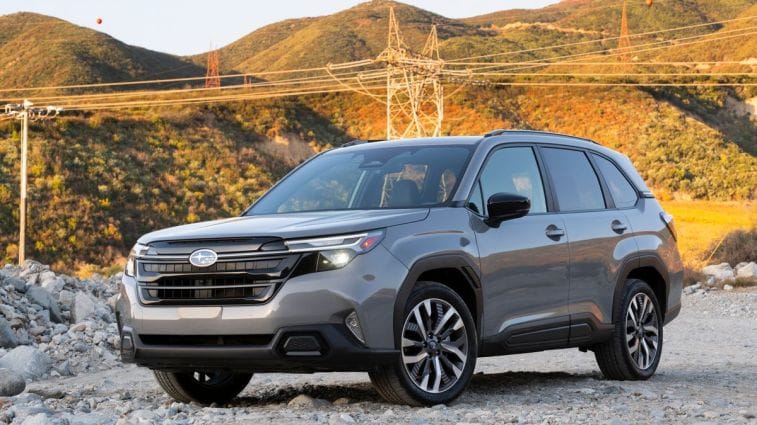
While the Forester brings up the rear here, it outranks plenty of compact SUVs not included in this test and lags merely a half-step behind some of the very best compact crossovers in the world. It didn’t help that the Forester we tested was a fully loaded Touring model and the most expensive vehicle in the group. “But it’s nearly $42,000!” was a common reply to any defense of one of the Forester’s quirks, including a relative shortage of power, noisy cabin, and unfortunate Starlink infotainment software.
Value is a legitimate concern for many compact SUV shoppers. The whole point of one of these vehicles is to perform the broadest range of functions well for the least money possible. The Forester does an admirable job of it; the others just do slightly better.
Adventure and Space at the Cost of Tech
The Forester did receive a lot of praise for its strengths. One of the things we liked most about the Forester is its excellent ride quality. The Forester soaks up bumps without jarring occupants or making booming sounds throughout the cabin. This agreeability over rough roads may be attributable to its more off-road-biased setup. That’s worth keeping in mind for rural buyers; we did all our testing on California highways and desert roads, which may have highlighted the other vehicles’ strengths more.
An attractive and roomy cabin is also high on the Forester’s list of strengths. Both front and second-row passengers have plenty of legroom, even for 6-footers. The cargo space behind the second row isn’t the best in the segment by the numbers, but it expands to nearly as much room as the CR-V with the seats laid down. Many enjoyed the mix of materials and colors in the cabin.
Many of us also noted the Forester’s more “truck-like” feel than the other crossovers. To me, it drives and feels a lot like a 2/3-scale Chevrolet Tahoe — and that’s definitely a compliment.
Our single biggest and most universal grievance with the new 2025 Forester is undoubtedly the Starlink infotainment system. Some disliked the screen’s vertical orientation because it made the driver cast their gaze lower and farther from the view out the windshield, potentially creating more distraction. Everyone disliked the software, which is slow, cumbersome, aggressively non-standard, and palpably behind the times, especially compared to the Tucson.
Overall, the 2025 Subaru Forester is an impressive compact SUV with a few areas that need improvement. If you’re like me and those areas overlap with feature sets that aren’t particularly important to you — say you care more about ride quality, ground clearance, and adventure capacity than infotainment — then the Forester is certainly worth a test drive.
— Editor Nelson Ireson
New 2025 Subaru Forester Prices
|
Retail Price
|
Fair Purchase Price (92620)
|
|||
|---|---|---|---|---|
TBD |
TBD |
|||
$34,805 |
$32,709 |
|||
$37,525 |
$35,159 |
|||
$37,705 |
$36,549 |
|||
$39,115 |
$36,604 |
|||
$43,015 |
$40,341 |
Rankings
Overall
- CR-V
- Tucson
- RAV4
- Forester
Power and Refinement
- CR-V
- Tucson
- RAV4
- Forester
Highway
- CR-V
- Tucson
- Forester
- RAV4
Steering and Brake Feel
- CR-V
- Tucson
- RAV4
- Forester
Advanced Driver Assist Systems (ADAS)
- Tucson
- CR-V
- RAV4
- Forester
Infotainment
- Tucson
- RAV4
- CR-V
- Forester
Cockpit
- Tucson
- CR-V
- RAV4
- Forester







